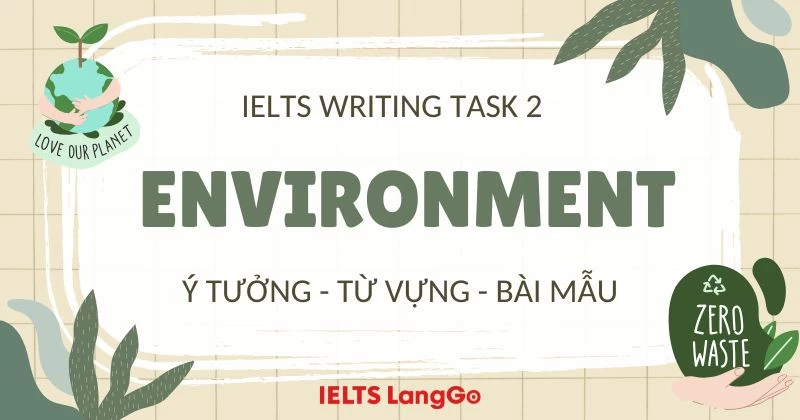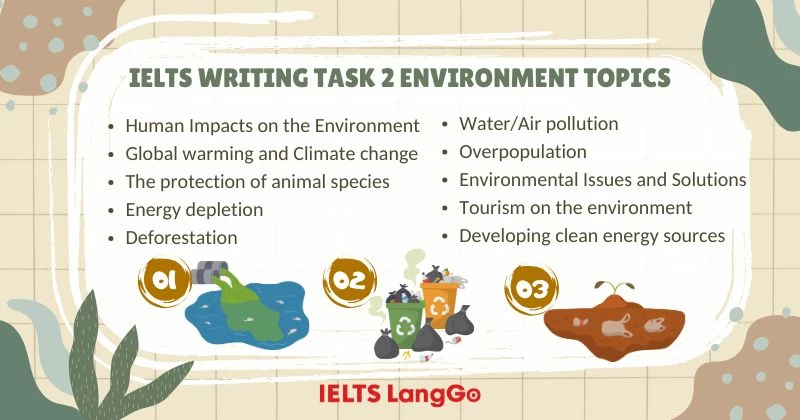


Environment (môi trường) là một trong những chủ đề hay gặp nhất trong IELTS Writing Task 2 bởi các vấn đề về môi trường là mối quan tâm toàn cầu và là chủ đề mà mọi thí sinh đều có thể thảo luận.
Trong bài viết này, IELTS LangGo sẽ giúp bạn nắm được các dạng câu hỏi về chủ đề Environment IELTS Writing Task 2, đồng thời tổng hợp các ý tưởng và từ vựng về Environmental problems topic kèm bài mẫu giúp bạn đạt band điểm cao hơn. Cùng tìm hiểu nhé!
Trong phần thi IELTS Writing Task 2, đề bài thường xoay quanh các vấn đề về môi trường (Environmental problems) nổi bật sau:

Ví dụ về các dạng đề Writing task 2 topic Environment thường gặp:
Ví dụ: The best way to solve the world's environmental problems is to increase the cost of fuel. To what extent do you agree or disagree?
Ví dụ: Some people believe that economic growth is the only way to end hunger and poverty, while others believe economic growth is causing damage to the environment that we should try to prevent. Discuss both views and give your opinion.
Ví dụ: The threat of climate change is increasing day by day. What are the causes of climate change? What solutions can you suggest?
Ví dụ: In many countries, plastic bags are banned in supermarkets. What are the advantages and disadvantages of this policy?
Trong phần này, chúng ta sẽ khám phá các ý tưởng giúp bạn viết bài hiệu quả cho các chủ đề liên quan đến môi trường phổ biến nhé.
| Causes | ● The discharge of untreated chemical effluents from factories directly into rivers, lakes, and oceans. This includes heavy metals, toxic compounds, and other hazardous waste products. ● The widespread use of chemical fertilizers and pesticides in agricultural practices which can leach into groundwater and surface water bodies. ● Improper disposal of household waste, sewage, and garbage, especially in areas without adequate waste management infrastructure. |
| Problems | ● Contamination of drinking water sources leads to serious health issues for local communities who rely on these water bodies. ● Disruption of aquatic ecosystems, with the death and displacement of fish, plants, and other marine life due to toxic pollution. ● Long-term impact on food security, as water pollution can accumulate in the food chain and make seafood and agricultural products unsafe for consumption. |
| Solutions | ● Strengthening environmental regulations and enforcement to ensure proper treatment and disposal of industrial and agricultural waste before it reaches water sources. ● Investing in the construction of wastewater treatment plants and sewage management systems, especially in rapidly urbanizing areas. ● Promoting sustainable agricultural practices that minimize the use of chemical inputs and encourage organic farming methods. |
| Causes | ● Clearing forested land to create more space for agriculture, livestock farming, and the expansion of human settlements and urban areas. ● Unsustainable logging and illegal harvesting of timber for commercial purposes, such as the production of wood products, paper, and fuel. ● Mining and extraction of natural resources often involves the destruction of forest habitats. |
| Problems | ● Loss of biodiversity as animal and plant species lose their natural homes and habitats. ● Disruption of local and global climate patterns, as forests play a crucial role in regulating temperature, rainfall, and carbon sequestration. ● Increased soil erosion, flooding, and landslides due to the loss of the natural protective cover provided by forests. |
| Solutions | ● Implementing stricter regulations and penalties to crack down on illegal deforestation activities, along with robust monitoring and enforcement mechanisms. ● Promoting sustainable forestry management practices that prioritize selective logging, reforestation, and the preservation of old-growth forests. ● Incentivizing the transition towards more eco-friendly alternative materials and renewable energy sources to reduce the demand for timber and forest resources. |
| Causes | ● The rapid growth of the tourism industry, leading to increased air travel and transportation to popular destinations around the world. ● Overcrowding and overuse of natural resources, such as water, energy, and land, in tourist hotspots that are unable to handle the influx of visitors. ● Improper waste management and pollution generated by tourism-related activities, including the generation of solid waste, wastewater, and greenhouse gas emissions. |
| Problems | ● Damage to fragile ecosystems and habitats, such as coral reefs, beaches, and mountain regions, due to excessive human activity and unsustainable practices. ● Strain on local infrastructure and public services, including water and electricity supply, waste management, and transportation systems. ● Cultural erosion and the displacement of indigenous communities, as traditional ways of life are disrupted by the influx of tourists and the commercialization of local traditions. |
| Solutions | ● Developing eco-tourism models and promoting sustainable tourism practices that prioritize environmental conservation and the well-being of local communities. ● Implementing visitor capacity limits, entrance fees, and other regulatory measures to control the number of tourists in sensitive natural areas. ● Investing in the development of waste management systems, renewable energy sources, and other sustainable infrastructure in popular tourist destinations. |
| Causes | ● The world's continued reliance on finite fossil fuel resources, such as oil, natural gas, and coal, to meet the growing global demand for energy. ● Inefficient energy consumption patterns across various sectors, including transportation, industry, and residential/commercial buildings. ● Lack of sufficient investment and innovation in the research, development, and deployment of renewable energy technologies. |
| Problems | ● Rising energy prices and potential supply disruptions, as the depletion of fossil fuel reserves leads to increased scarcity and geopolitical tensions over the control of these resources. ● Increased greenhouse gas emissions and accelerated climate change, as the burning of fossil fuels releases large amounts of carbon dioxide and other pollutants into the atmosphere. ● Potential conflicts and social unrest due to the unequal distribution of energy resources and the disproportionate impact of energy depletion on vulnerable communities. |
| Solutions | ● Transitioning towards a more diversified energy mix that places a greater emphasis on renewable sources, such as solar, wind, hydropower, and geothermal energy. ● Improving energy efficiency through technological advancements, policy measures, and changes in consumer behavior, such as the adoption of energy-efficient appliances, buildings, and transportation. ● Encouraging increased investment, research, and development in clean energy technologies to drive down costs and improve the viability of renewable energy alternatives. |
| Causes | ● Growing global awareness and concern about the environmental and climate-related impacts of fossil fuel-based energy generation, leading to a greater demand for sustainable energy solutions. ● Significant advancements in renewable energy technologies, including improved solar photovoltaic cells, wind turbines, energy storage systems, and smart grid infrastructure. ● Government policies, incentives, and regulations that aim to promote the adoption and deployment of clean energy alternatives, such as carbon pricing, feed-in tariffs, and renewable energy targets. |
| Problems | ● Higher upfront capital costs associated with the installation and implementation of clean energy systems, which can be a barrier to widespread adoption, especially in developing countries. ● Intermittency and storage challenges for some renewable energy sources, such as solar and wind, which can lead to reliability concerns and the need for complementary technologies. ● Resistance and lobbying efforts from fossil fuel-based industries and concerns about potential job losses in traditional energy sectors, which can slow the transition towards clean energy. |
| Solutions | ● Increasing public and private investment in the development of clean energy infrastructure, including utility-scale renewable energy projects, distributed generation systems, and energy storage facilities. ● Implementing a range of financial incentives, such as carbon pricing, subsidies, tax credits, and feed-in tariffs, to make clean energy technologies more cost-competitive and attractive for investors and consumers. ● Promoting education, training, and job creation programs in the renewable energy sector to facilitate a just transition and ensure that the economic benefits of the clean energy transition are equitably distributed. |
Để đạt band điểm cao trong bài viết IELTS Writing Task 2 Environment topics, bạn cần trang bị cho mình vốn từ vựng về chủ đề môi trường.
Trong phần này, IELTS LangGo sẽ tổng hợp cho bạn từ vựng chủ đề môi trường theo từng subtopic kèm dịch nghĩa và ví dụ giúp bạn cải thiện điểm Lexical resources trong Writing task 2.

| Từ vựng | Dịch nghĩa | Ví dụ |
| Deforestation | Nạn phá rừng | Widespread deforestation in the Amazon rainforest has led to significant biodiversity loss and contributes to global climate change. |
| Afforestation | Trồng lại rừng | The government's afforestation program aims to plant millions of trees in previously barren areas, creating new forest ecosystems where none existed before. |
| Reforestation | Tái trồng rừng | Reforestation efforts in areas that were previously logged have proven successful in restoring degraded ecosystems and providing habitats for displaced wildlife. |
| Habitat | Môi trường sống | The destruction of natural habitats is the primary cause of species extinction worldwide, highlighting the urgent need for conservation efforts. |
| Biodiversity | Đa dạng sinh học | Tropical rainforests support incredible biodiversity, housing more than half of the world's plant and animal species despite covering less than 7% of Earth's land surface. |
| Logging | Khai thác gỗ | Sustainable logging practices ensure that forests can regenerate naturally and continue to provide economic benefits without permanent ecological damage. |
| Slash-and-burn | Phương pháp đốt phá rừng | Slash-and-burn agriculture remains common in developing regions, where farmers clear forested land by cutting and burning vegetation before planting crops. |
| Old-growth forest | Rừng già | Old-growth forests contain trees that may be hundreds or even thousands of years old, making them irreplaceable repositories of ecological history and biodiversity. |
| Timber | Gỗ | The demand for exotic timber continues to drive illegal logging in protected areas, undermining conservation efforts worldwide. |
| Illegal poaching | Săn bắt trái phép | Illegal poaching for wildlife products has pushed numerous forest species to the brink of extinction, disrupting entire ecosystem functions. |
| Từ vựng | Dịch nghĩa | Ví dụ |
| Marine pollution | Ô nhiễm môi trường biển | Marine pollution from plastic waste has reached crisis levels, with devastating impacts on sea creatures that ingest or become entangled in debris. |
| Overfishing | Khai thác quá mức | Overfishing has depleted numerous fish stocks worldwide, threatening food security for millions of people who depend on seafood as their primary source of protein. |
| Coral reef | San hô | Climate change and ocean acidification pose existential threats to coral reefs, which are often described as the rainforests of the sea due to their rich biodiversity. |
| Coastal erosion | Xói mòn bờ biển | Rising sea levels have accelerated coastal erosion in many regions, forcing communities to consider relocation or expensive protective infrastructure. |
| Acidification | Độ axit hóa | Ocean acidification caused by increased carbon dioxide absorption is altering marine chemistry, making it difficult for shellfish and corals to form their calcium carbonate structures. |
| Plastic waste | Rác thải nhựa | Plastic waste can persist in marine environments for centuries, breaking down into microplastics that enter the food chain with as-yet-unknown consequences for human health. |
| Oil spill | Tràn dầu | A single major oil spill can cause environmental damage that persists for decades, as evidenced by the long-term effects of the Exxon Valdez disaster on Alaskan ecosystems. |
| Microplastics | Vi nhựa | Microplastics have been detected in even the most remote oceanic regions, including the Mariana Trench, demonstrating the pervasive nature of this pollution. |
| Sustainable fishing | Đánh bắt cá bền vững | Implementing sustainable fishing practices is crucial to ensure that marine resources can continue to provide nutrition and livelihoods for future generations. |
| Mariculture | Nuôi trồng thủy sản | When properly managed, mariculture can provide a sustainable alternative to wild-caught seafood, reducing pressure on overexploited fish stocks. |
| Từ vựng | Dịch nghĩa | Ví dụ |
| Fossil fuels | Nhiên liệu hóa thạch | Despite their environmental impact, fossil fuels still account for over 80% of global energy consumption, highlighting the challenges of transitioning to cleaner alternatives. |
| Renewable energy | Năng lượng tái tạo | Investment in renewable energy has grown exponentially in recent years as costs have fallen and concerns about climate change have increased. |
| Solar power | Năng lượng mặt trời | Solar power installations are becoming increasingly common on residential buildings, allowing homeowners to generate their own electricity and reduce their carbon footprint. |
| Wind power | Năng lượng gió | Offshore wind power has enormous potential to supply clean energy to coastal populations, though concerns about impacts on marine life must be carefully addressed. |
| Hydropower | Thủy điện | While hydropower provides renewable energy, large dam projects can disrupt river ecosystems and displace communities, requiring careful impact assessment. |
| Geothermal energy | Năng lượng địa nhiệt | Geothermal energy offers a reliable, constant source of power in regions with suitable geological conditions, unlike the intermittent nature of solar and wind. |
| Biofuels | Nhiên liệu sinh học | Advanced biofuels derived from non-food sources represent a promising alternative to conventional transportation fuels, though scalability remains challenging. |
| Energy efficiency | Tiết kiệm năng lượng | Improving energy efficiency in buildings and industrial processes often represents the most cost-effective approach to reducing carbon emissions. |
| Carbon footprint | Dấu chân carbon | Understanding and reducing one's carbon footprint has become increasingly important as consumers seek to make environmentally responsible choices. |
| Greenhouse gas emissions | Khí nhà kính | International agreements aim to limit greenhouse gas emissions to levels that will prevent catastrophic climate change, though implementation remains inconsistent. |
| Từ vựng | Dịch nghĩa | Ví dụ |
| Air pollution | Ô nhiễm không khí | Air pollution in major urban centers contributes to millions of premature deaths annually, making it one of the leading environmental health risks worldwide. |
| Water pollution | Ô nhiễm nước | Industrial discharge and agricultural runoff are primary sources of water pollution, contaminating drinking water sources for billions of people globally. |
| Soil pollution | Ô nhiễm đất | Heavy metals and persistent organic pollutants can remain in soil for centuries, rendering contaminated land unsuitable for agriculture or residential development. |
| Noise pollution | Ô nhiễm tiếng ồn | Though often overlooked, noise pollution from transportation and industrial activities can cause significant health problems, including stress, sleep disturbance, and hearing loss. |
| Toxic waste | Chất thải độc hại | Improper disposal of toxic waste can lead to environmental disasters with long-lasting consequences, as demonstrated by notorious cases like Love Canal in the United States. |
| Emission | Khí thải | Vehicle emissions in congested urban areas contribute significantly to smog formation and respiratory health problems among city residents. |
| Landfill | Bãi rác | Modern landfills incorporate sophisticated containment systems to prevent leachate from contaminating groundwater, though space for such facilities is increasingly limited. |
| Recycling | Tái chế | Effective recycling programs can divert significant volumes of waste from landfills, conserve natural resources, and reduce energy consumption in manufacturing. |
| Waste management | Quản lý chất thải | Integrated waste management approaches combining reduction, reuse, recycling, and energy recovery represent best practices for minimizing environmental impact. |
| Sewage | Nước thải | Untreated sewage discharge remains a major environmental and public health concern in many developing regions lacking adequate wastewater infrastructure. |
| Từ vựng | Dịch nghĩa | Ví dụ |
| Global warming | Sự nóng lên toàn cầu | The evidence for global warming is unequivocal, with average temperatures increasing approximately 1°C since pre-industrial times. |
| Greenhouse effect | Hiệu ứng nhà kính | The greenhouse effect is essential for making Earth habitable, but human activities have enhanced this natural process, leading to unprecedented warming. |
| Carbon sequestration | Hấp thụ carbon | Natural carbon sequestration in forests and oceans has slowed the accumulation of atmospheric carbon dioxide, though these sinks are now showing signs of saturation. |
| Extreme weather | Thời tiết cực đoan | Climate models predict increasing frequency and intensity of extreme weather events, including hurricanes, droughts, and heatwaves, as global temperatures rise. |
| Sea level rise | Mực nước biển dâng | Sea level rise threatens coastal communities worldwide, with some island nations facing existential risk from even moderate climate change scenarios. |
| Melting glaciers | Băng tan | The accelerated melting of glaciers not only contributes to sea level rise but also threatens water security for millions of people dependent on glacial meltwater. |
| Desertification | Sa mạc hóa | Desertification affects approximately one-third of Earth's land surface, reducing agricultural productivity and forcing population displacement in affected regions. |
| Mitigation | Giảm thiểu | Climate mitigation strategies focus on reducing emissions through renewable energy deployment, energy efficiency improvements, and changes in land use practices. |
| Adaptation | Thích ứng | Climate adaptation measures range from drought-resistant crops to coastal defense systems, reflecting the reality that some degree of climate change is now unavoidable. |
| Sustainability | Bền vững | True sustainability requires balancing environmental protection with social equity and economic development to meet present needs without compromising future generations. |
| Từ vựng | Dịch nghĩa | Ví dụ |
| Pesticides | Thuốc trừ sâu | Excessive pesticide use can lead to soil and water contamination, beneficial insect decline, and health risks for agricultural workers and consumers. |
| Fertilizers | Phân bón | Chemical fertilizers have dramatically increased crop yields but also contribute to water pollution through nutrient runoff causing eutrophication in lakes and coastal areas. |
| Monoculture | Trồng một loại cây | Industrial monoculture farming maximizes short-term productivity but increases vulnerability to pests and diseases while reducing biodiversity. |
| Organic farming | Nông nghiệp hữu cơ | Organic farming practices avoid synthetic pesticides and fertilizers, promoting soil health and biodiversity while reducing environmental pollution. |
| Sustainable agriculture | Nông nghiệp bền vững | Sustainable agriculture aims to meet present food needs while enhancing environmental quality and conserving resources for future generations. |
| Crop rotation | Luân canh cây trồng | Implementing crop rotation helps maintain soil fertility, reduce pest and disease pressure, and minimize the need for synthetic inputs. |
| Livestock farming | Chăn nuôi gia súc | Intensive livestock farming contributes significantly to greenhouse gas emissions, water pollution, and land degradation worldwide. |
| Depletion of soil | Suy thoái đất | Continuous intensive cultivation without proper soil management leads to depletion of essential nutrients and reduced agricultural productivity over time. |
| Irrigation | Tưới tiêu | While irrigation enables agriculture in arid regions, inefficient systems can contribute to water scarcity and salinization of soils. |
| Land degradation | Suy thoái đất đai | Land degradation affects nearly 30% of the Earth's land area, threatening food security and rural livelihoods in many regions. |
| Từ vựng | Dịch nghĩa | Ví dụ |
| Urban sprawl | Sự lấn chiếm đô thị | Urban sprawl increases dependency on private vehicles, leading to higher emissions, habitat loss, and inefficient land use. |
| Congestion | Ùn tắc giao thông | Traffic congestion in major cities contributes to air pollution, economic losses through wasted time, and reduced quality of life for residents. |
| Waste management | Quản lý chất thải | Effective waste management in densely populated urban areas requires comprehensive approaches integrating collection, segregation, recycling, and disposal. |
| Green spaces | Không gian xanh | Urban green spaces provide multiple benefits, including air filtration, temperature moderation, stormwater management, and mental health benefits for residents. |
| Brownfield redevelopment | Phát triển lại khu công nghiệp cũ | Brownfield redevelopment transforms contaminated former industrial sites into productive uses, reducing pressure for greenfield development while remediating pollution. |
| Sustainable cities | Các thành phố bền vững | Sustainable cities prioritize compact development, public transportation, energy efficiency, and green infrastructure to minimize environmental impacts. |
| Smart growth | Tăng trưởng thông minh | Smart growth principles encourage development that serves the economy, community, and environment through compact design and preservation of natural areas. |
| Urban heat island | Hiệu ứng đảo nhiệt đô thị | The urban heat island effect can raise city temperatures several degrees above surrounding rural areas, increasing energy demand for cooling and exacerbating heat-related health risks. |
| Public transit | Giao thông công cộng | Well-developed public transit systems reduce transportation emissions while improving mobility for all urban residents, particularly those without access to private vehicles. |
| Eco-friendly buildings | Tòa nhà thân thiện với môi trường | Eco-friendly buildings incorporate energy-efficient design, renewable energy systems, water conservation features, and sustainable materials to minimize environmental impact. |
Sau đây là 2 bài mẫu chủ đề Environment IELTS Writing Task 2 kèm dàn ý giúp bạn nắm được cách viết về chủ đề này.
Bạn hãy tham khảo ý tưởng, cách lên dàn ý và ghi chép lại từ vựng và cấu trúc hay để vận dụng vào bài viết của mình nhé.
Đề bài:
| Some people say that the main environmental problem of our time is the loss of particular species of plants and animals. Others say that there are more important environmental problems. Discuss both these views and give your own opinion. Give reasons for your answer and include any relevant examples from your own knowledge or experience. Write at least 250 words. |
Dàn ý:
Introduction
Body 1: Loss of particular species of plants and animals is the main environmental problem
Body 2: There are more important environmental problems than just species loss
Conclusion
Bài mẫu:
There exists a heated debate in the modern world about the most pressing environmental issue. While some people claim the loss of species is a critical problem, I believe that other environmental problems pose a greater threat to our planet.
Admittedly, it is without a doubt that species loss contributes to the alarming rate at which biodiversity is declining globally. The destruction of natural habitats through deforestation, urbanization, and agricultural expansion is seen as a key driver of this crisis. When entire ecosystems are disrupted, the interdependence of species means that the loss of one can have cascading effects on the rest of the food chain and the overall health of the environment.
Nonetheless, in my opinion, there are other graver environmental problems that deserve one’s attention. One of the most pressing issues at the moment is climate change, which poses existential threats that transcend the loss of individual species. Due to the burning of fossil fuels and the release of greenhouse gases, the climate has undergone significant irreversible changes in its temperature, leading to extreme weather events and sea level rise. This could wipe out the entirety of human civilization and the planet as a whole. If this issue is not resolved in a timely manner, the consequence is far more widespread and severe than what an unbalanced ecosystem can ever bring.
In conclusion, while the species issue is harmful in its own way, I advocate for prioritising solving the climate change that is imperiling the future of our planet. Preserving our climate must be a key part of a broader strategy to tackle the existential threats facing the natural world and human civilization.
Đề bài:
| Some countries have encouraged the use of renewable energy sources to replace fossil fuels. Do you think the advantages of this approach outweigh the disadvantages? Give reasons for your answer and include any relevant examples from your own knowledge or experience. Write at least 250 words. |
Dàn ý:
Introduction
Introduce the topic of government incentives for renewable energy
Outline the views, and state your opinion clearly.
Body 1: Challenges and Disadvantages of Renewable Energy
Body 2: Advantages of Renewable Energy
Conclusion
Bài mẫu:
As the world grapples with the depletion of finite fossil fuel resources, the development of clean energy sources has become a critical priority for environmental sustainability. With growing global awareness and concern about the detrimental impact of greenhouse gas emissions and pollution, there is a widespread recognition of the urgent need to transition towards more renewable and eco-friendly energy alternatives.
The transition to clean energy is not without its challenges. One of the primary obstacles is the higher upfront costs associated with the deployment of renewable energy technologies. Addressing this financial barrier will require a combination of policy interventions,which can also be time-consuming. Another challenge is the intermittent nature of some renewable energy sources, such as solar and wind, which can create issues with grid integration and energy storage. For one to overcome these technical hurdles, it will take further advancements in technology that may be unavailable in some developing countries, making it difficult and expensive to apply.
However, reduction of emissions and economic growth are the two strongest reasons to advocate for clean energy. Firstly, the transition away from fossil fuels can play a crucial role in mitigating the effects of global warming and helping countries meet their greenhouse gas reduction targets. If countries do not turn to renewable energy, sooner or later, their natural resources will be completely depleted, leading to an unprecedented environmental crisis. Moreover, the clean energy sector also presents substantial economic opportunities. The growth of renewable energy industries can create various new job prospects, from the manufacturing and installation of solar panels and wind turbines to the operation of these systems.
In conclusion, while there are significant challenges to overcome, it is my firm belief that the benefits of sustainable energy outweigh the negligible drawbacks. The environmental impacts and economic opportunities make renewable energy a vital imperative for the protection of our planet.
Chủ đề Environment IELTS Writing Task 2 đòi hỏi thí sinh không chỉ nắm vững từ vựng chuyên ngành mà còn phải có kiến thức sâu rộng về các vấn đề môi trường toàn cầu.
Các bạn hãy cập nhật kiến thức thời sự về các vấn đề môi trường để có những ví dụ cụ thể, thực tế góp phần làm tăng tính thuyết phục cho bài viết. Đồng thời, thực hành thường xuyên với các dạng đề khác nhau để cải thiện kỹ năng viết nhé.



ĐẶT LỊCH TƯ VẤN MIỄN PHÍ LỘ TRÌNH Săn ƯU ĐÃI lên tới 12.000.000đ